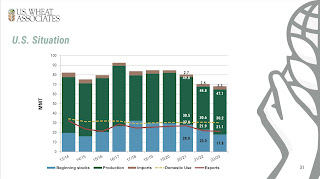The war in Ukraine put a drastic shortage on wheat in Europe. Ukraine is one of Europe’s largest wheat exporters. Drought in the United States left the winter wheat crops in a deplorable state. The U.S. Department of Agriculture said 30% of U.S. winter wheat was in good or excellent condition as of April 3, well below the trade expectation for 40% and the year-ago 53%. That was the agency’s first national assessment of wheat conditions since late November.
Winter wheat production represents approximately 70 percent of total U.S. production, on average. US farmers planted 34.4 million acres of winter wheat for 2022, the most in six years (USDA, January). However, most of the Plains breadbasket is in the grip of a drought that is expected to persist through April, according to the latest seasonal outlook from the U.S. Climate Prediction Center. April rain, the most important element in a successful wheat crop for US production, was less than needed. Despite the increased planting, in May the USDA forecast an 8% reduction in output from 2021.
Globally, the wheat situation is bad everywhere except Russia. Ukrainian production is diminished and what is produced will be unavailable for export due to war. India has faced such a heat wave that crops are damaged, leading the country to forgo exports altogether, keeping such wheat as they can produce for domestic use. The USDA expects total world wheat production will decline 0.6% in 2022/23, with a 35% drop in Ukraine accounting for the biggest shortfall. Wheat crops in other countries are suffering from drought, including Morocco, where production is projected to be down 70%. As a result, the agency lowered its projection for world wheat ending stocks by 5% , the lowest level in six years.
All of this has pushed wheat futures soaring. Chicago futures for wheat are nearly double what they were in July.
Americans eat an amazing amount of wheat, even if they don’t realize it. Cookies, bread, noodles, you name it, wheat is on the menu nearly every meal, and definitely the backbone of snacks and desserts. The U.S., once the bread basket to the world, has been importing wheat to make up its shortfall over the past decade. As we go into the 2022/2023 year, the May report of the US Wheat Associates shows beginning stocks are down, production is expected to be down to decade lows, and consumption shows no sign of decline. Further weather fluctuations could imperil the reduced projections. Our staple food could get very expensive very fast.

